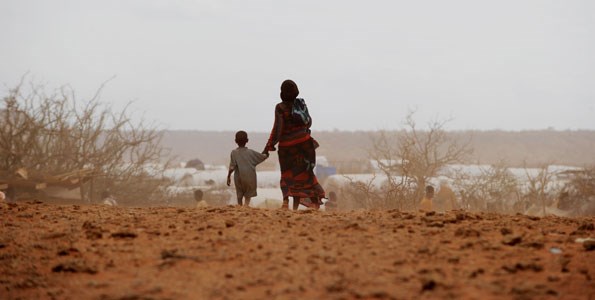
Saturday January 21, 2017

A mother and son at the Kobe refugee camp near the Ethiopia-Somalia border. Failure of rains over the past two years has caused a severe drought, affecting thousands in Somalia. PHOTO | FILE
Until he breathed his last, Mr Omar Hassan led a decent life as pastoralist in central Somalia's Galgadud region.
He was comfortable, earning and eating his daily bread.
But with diminishing water and pasture in the Horn of Africa country, Mr Hassan's fortunes started dwindling. His livestock couldn't take the heat and died one by one leaving him a pauper.
In November last year, Mr Hassan was left with an empty kraal after his livestock died. He committed suicide.
“Omar Hassan first suffered some kind of depression,” a relative told reporters mid-November last year. “Unfortunately, he could not regain full composure as his animals died one-by-one,” he added.
Some say that at least two more people are known to have committed suicide after witnessing the deaths of their animals due to lack of pasture and water.
Severe drought
Although the drought affects all kinds of communities, the pastoralists, who chiefly depend on rain water are most affected.
In March last year, the United Nations Office for the Coordination of Humanitarian Affairs (UN-OCHA) declared that severe drought exacerbated by the El Niño phenomenon had hit parts of Puntland and Somaliland, two northern regions of Somalia.
Failure of rains over the past two years has caused a severe drought, affecting thousands in the Horn of Africa country.
“Worsening drought conditions across the country have left hundreds of thousands of Somalis facing severe food and water shortages,” UN-OCHA affirmed.
According to the UN, some five million people (40 per cent of the population) are in need of humanitarian assistance while more than 1.1 million of these in “crisis” and “emergency”.
Search for pastures
Since last year, things have worsened, especially after the failure of the last dayr (short rains) with clouds disappearing towards the end of the year.
As a result, most Somali regions from Sanaag in the northwest to Gedo in the south, millions of people and their livestock have been on a desperate move in search of pasture and water.
A legislator from Jubaland Administration, Mohamed Da’uud who visited Gedo region in November 2016 expressed shock. “Anyone with resources must help,” said Mr Da’uud.
“People in Bardere district are harshly affected by the serious shortage of food, water and medication,” he added, calling on the federal government, the local Interim Jubaland Authority and the international community to help. Bardere is about 341 km south of the capital Mogadishu.
Drought committee
The Puntland Authority, in northeastern Somalia has set up a team to tackle the drought in its five regions.
The committee chairman, Abdullahi Hashi alias Qoob-deero, the authority’s deputy minister of internal affairs, described the situation in Bari, Mudug, Nugal and parts of Sool and Sanaag as dire.
Late last December, Mr Hashi revealed that herders were losing a large number of their livestock, including cattle, goats and camels.
In a bid to save lives, the Puntland drought committee has initiated a water distribution operation. Mr Hashi recently told the press that he has been getting horrifying stories from the rural areas.
“Committee members who visited the drought-hit areas have seen enormous suffering including that of a two-year-old girl who had no water to drink for over 24 hours,” said Mr Hashi. “They had also met a lactating mother, who had gone without food or drink for 36 hours."
In Somaliland, the drought has been equally devastating, particularly in the eastern regions.
“The drought is fast spreading,” said Osman Dhere, an elder who has since moved his family from Sanaag in the east to Wajaale, a border district between Somaliland and Ethiopia.
Fundraising campaign
Across the Somali regions, water sources are far in between. Sometimes, pastoralists have to walk for over 100 kilometres to get water.
“We have lost most of our animals. The remaining need feed and water as the land can no longer provide pasture,” Mr Dhere added.
Traditional elders in Somaliland and Puntland have launched a fundraising campaign to support to nomads who have lost their livestock. “One (US) dollar may save a life,” declared a member of drought committee in Somaliland.